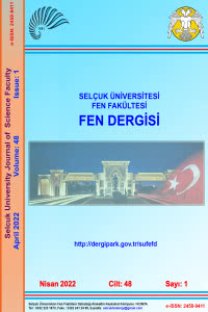REMOVAL OF REACTIVE BLUE 19 FROM AQUEOUS SOLUTION BY PEANUT SHELL: OPTIMIZATION BY RESPONSE SURFACE METHODOLOGY
Sulu Çözeltilerden Yer Fıstığı Kabukları ile Reaktif Mavi 19 Giderimi: Cevap Yüzey Yöntemi ile Optimizasyonu
___
- Arunachalam, R., Annadurai, G., 2011, “Optimized Response Surface Methodology for Adsorption of Dyestuff from Aqueous Solution”, Journal of Environmental Science and Technology, Vol. 4, pp. 65-72.
- Asgher, M., Bhatti, H.N., 2012, “Removal of Reactive Blue 19 and Reactive Blue 49 Textile Dyes by Citrus Waste Biomass from Aqueous Solutıon: Equilibrium and Kinetic Study”, The Canadian Journal of Chemical Engineering, Vol. 90, p.412-419.
- Cheng, Z., Zhang, L., Guo, X., Jiang, X., Li, T., 2015, “Adsorption Behavior of Direct Red 80 and Congo Red onto Activated Carbon/Surfactant: Process Optimization, Kinetics and Equilibrium”, Spectrochimica Acta Part A: Molecular and Biomolecular Spectroscopy, Vol. 137, pp.1126 –1143.
- Dada, A.O., Olalekan, A.P., Olatunya, A.M., Dada, O., 2012, “Langmuir, Freundlich, Temkin and Dubinin–Radushkevich Isotherms Studies of Equilibrium Sorption of Zn2+ Unto Phosphoric Acid Modified Rice Husk”, IOSR Journal of Applied Chemistry, Vol. 3, No. 1, pp. 38 -45.
- Daneshvara, E., Koushaa, M., Sohrabia, M.S., Panahbehaghb, B., Bhatnagarc, A., Younesid, H., Sternberg, S.P.K., 2015, “Application of Response Surface Methodology for The Biosorption of Acid Blue 25 Dye Using Raw and HCl-Treated Macroalgae”, Desalination and Water Treatment, Vol. 53, pp.1710–1723.
- Dutta, S., 2013, “Optimization of Reactive Black 5 Removal by Adsorption Process Using Box–Behnken Design, Desalination and Water Treatment, Vol. 51, pp.7631–7638.
- El-Bindary, A.A., Abd El-Kawi, M.A., Hafez, A.M., Rashed, I.G.A., Aboelnaga, E.E., 2016, Removal of Reactive Blue 19 from Aqueous Solution Using Rice Straw Fly Ash, Journal of Materials and Environmental Sciences, Vol. 7, No. 3, pp.1023-1036.
- Etorki, A.M., Massoudi, F.M.N., 2011, “The Use of Peanut Hull for the Adsorption of Colour from Aqueous Dye Solutions and Dye Textile Effluent”, Oriental Journal of Chemistry, Vol. 27, No. 3, pp.875-884.
- Ghaneian, M.T., Ehrampoush, M.H., Sahlabadi, F., Mootab, M., Rezapour, I., Jasemizad, T., 2014, “Reactive Blue 19 Dye Adsorption Behavior on Jujube Stems Powder from Syntetic Textile Wastewater: Isotherm and Kinetic Adsorption Studies”, Journal of Community Health Research, Vol. 3, No. 1, pp.67-78.
- Khan, A.S.A., 2012, “Evaluation of Thermodynamic Parameters of Cadmium Adsorption on Sand from Temkin Adsorption Isotherm”, Turkish Journal of Chemistry, Vol. 36, pp. 437 – 443
- Koushaa, M., Daneshvara, E., Dopeikara, H., Taghavia, D., Bhatnagarb, A., 2012, “Box–Behnken Design Optimization of Acid Black 1 Dye Biosorption by Different Brown Macroalgae”, Chemical Engineering Journal, Vol. 179, pp.158– 168.
- Liu, Y., Zheng, Y., Wang, A., 2010, “Response Surface Methodology for Optimizing Adsorption Process Parameters for Methylene Blue Removal by a Hydrogel Composite”, Adsorption Science & Technology, Vol. 28, No. 10, pp.913-922.
- Piccin, J.S., Dotto, G.L., Pinto, L.A.A., 2011, “Adsorption Isotherms and Thermochemical Data of FD&C Red n° 40 Binding by Chitosan”, Brazilian Journal of Chemical Engineering, Vol. 28, No. 02, pp. 295 – 304.
- Ravikumara, K., Pakshirajanb, K., Swaminathanc, T., Balua, K., 2005, “Optimization of Batch Process Parameters Using Response Surface Methodology for Dye Removal by A Novel Adsorbent”, Chemical Engineering Journal, Vol. 105, pp.131–138.
- Sampranpiboon, P., Charnkeitkong, P., Feng, X., 2014, “Equilibrium Isotherm Models for Adsorption of Zinc (II) ion from Aqueous Solution on Pulp Waste”, Wseas Transactions on Environment and Development, Vol. 10, pp. 35-47.
- Zaidi, Y.R., Mohd Zulkhairi, A.R., 2014, “Removal of Methyl Red From Aqueous Solution by Adsorption on Treated Banana Pseudostem Fibers Using Response Surface Method (RSM)”, The Malaysian Journal of Analytical Sciences, Vol. 18, No. 3, pp.592 – 603.
- ISSN: 2147-9364
- Yayın Aralığı: 2
- Başlangıç: 2013
- Yayıncı: Selçuk Üniversitesi Mühendislik Fakültesi
HALİL AKINCI, SEDAT DOĞAN, CEM KILIÇOĞLU
GEOLOGICAL AND GEOMECHANICAL PROPERTIES OF SOME CARBONATE MARBLES AND BASALT STONE FROM MOROCCO
VEYSEL ZEDEF, KERİM KOÇAK, Najib Mohamed ZAGHLOUL, ADNAN DÖYEN, ALİ RIZA SÖĞÜT, HAKAN ÖZŞEN, BİLGEHAN KEKEÇ, ALİ ARAS, KEMAL DOĞAN, TEVFİK AĞAÇAYAK
YERALTI LİNYİT KÖMÜR MADENİNDE TERMAL KONFOR ŞARTLARININ İNCELENMESİ
SULPHURIC ACID LEACHING UNDER EFFECT OF SODIUM FLUORIDE
BER OF ANNULAR BEAMS IN WEAK OCEANIC TURBULENCE
EFFECT OF HEIGHT ON THE STATIC STABILITY OF HETEROGENEOUS EMBANKMENT DAMS
Mohsen YAZDANIAN, Hamid Reza AFSHOON, Sadegh GHASEMI, Vahid AFSHOON, Farhad FAHIM
